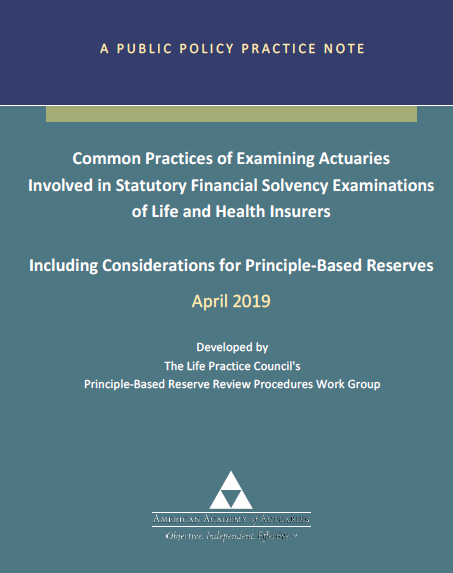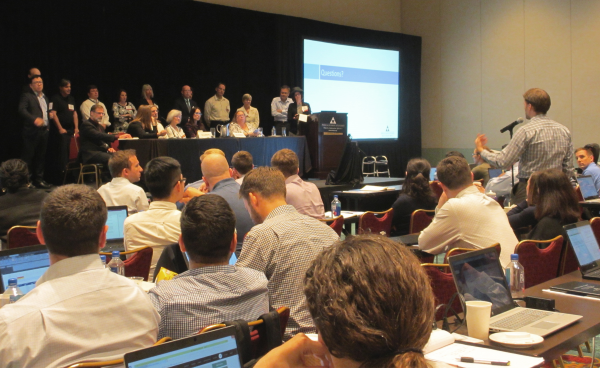Vol 2 | No. 2
Public Policy Practice Note Exposure Draft Looks at PBR, Financial Solvency Examinations
 Common Practices of Examining Actuaries Involved in Statutory Financial Solvency Examinations of Life and Health Insurers, Including Considerations for Principle-Based Reserves. The practice note—intended to provide an outline of how some actuaries approach risk-focused examinations (RFEs), particularly with PBR considerations—was developed primarily to assist examining actuaries in coordinating with an Examiner in Charge (EIC) and in effectively conducting RFEs.
Common Practices of Examining Actuaries Involved in Statutory Financial Solvency Examinations of Life and Health Insurers, Including Considerations for Principle-Based Reserves. The practice note—intended to provide an outline of how some actuaries approach risk-focused examinations (RFEs), particularly with PBR considerations—was developed primarily to assist examining actuaries in coordinating with an Examiner in Charge (EIC) and in effectively conducting RFEs.
Three key efficiencies of the RFE for examining actuaries are:
- Only systemic or material risks are considered;
- The way a company controls its risks drives the depth of examination required; and
- Examiners (including examining actuaries) can rely on the work of outside auditors.
A secondary purpose of the practice note is that a basic understanding of the RFE approach related to actuarial services can help actuaries fulfill their roles in an examination. Additionally, company actuaries, peer reviewers, and internal and outside auditors can benefit from understanding the examination process and what is required of examiners. Comments are due July 1; read the Academy alert.
Life Perspectives asked Randall Stevenson, chairperson of the work group, some general questions about the practice note.
How can this practice note help actuaries in their work since the widespread implementation of PBR?
PBR is a risk-focused reserving paradigm. One of the key differences is the change of focus from prescribed methods and assumptions to process-based methods and assumptions. Documentation of risk mitigation, sensitivity measurements, and development of assumptions and processes will be much more important in a PBR environment from the regulatory perspective.
How can the practice note prepare or improve the preparation of actuaries who are handling RFEs?
The practice note provides actuaries performing examinations some ideas of what other examining actuaries are doing. It also provides actuaries, whose work may be examined, some insight on the examination process and how to prepare their documentation to allow the process to proceed smoothly. It can also be a source of consideration for an actuary performing a peer review.
How can this document advance actuaries’ coordination and/or cooperation with the NAIC and its Valuation Manual?
 Communication and understanding are principles that underlie coordination and cooperation. The practice note is intended to increase understanding of the regulatory perspective and examination processes for actuaries performing examinations and actuaries whose work is subject to examination. Several actuaries with and without regulatory experience were intentionally included in the work group to ensure the information was communicated in a manner understandable by actuaries working in various roles. By providing insight into the regulatory perspective, the practice note can help actuaries communicate more efficiently within the examination framework, which extends to operations of the NAIC and its Valuation Manual.
Communication and understanding are principles that underlie coordination and cooperation. The practice note is intended to increase understanding of the regulatory perspective and examination processes for actuaries performing examinations and actuaries whose work is subject to examination. Several actuaries with and without regulatory experience were intentionally included in the work group to ensure the information was communicated in a manner understandable by actuaries working in various roles. By providing insight into the regulatory perspective, the practice note can help actuaries communicate more efficiently within the examination framework, which extends to operations of the NAIC and its Valuation Manual.
The practice note mentions several actuarial standards of practice (ASOPs), including ASOP No. 41, Actuarial Communications. How do these fit into the considerations of the practice note?
A risk-focused examination can include the risk of the actuaries’ compliance with statutes, regulations, and standards of practice. Furthermore, the examining actuaries could use the referenced ASOPs to assist them in their analysis and communication.
Is this practice note primarily for life actuaries, or would it also be equally applicable to health actuaries?
The practice note has a risk-focused examination process as its foundation, which is applicable to all lines of insurance, including life, health and property/casualty; however, the considerations for PBR are usually specific to life insurance products.
Where can actuaries find more information or continuing education to become more familiar with PBR?
The contents of VM-20 are foundational to PBR. There have been several PBR Boot Camps offered by the Academy, and more might be offerred. Following the actions and meetings of the NAIC’s Life Actuarial Task Force (LATF) can help actuaries keep abreast of emerging issues, changes under consideration, and the history and reasoning for decisions.
Academy Presents at NAIC Spring National Meeting
Academy volunteers delivered a series of life presentations at the NAIC Spring 2019 National Meeting in Orlando, Fla., in early April. Presentations to LATF included:
- Linda Lankowski, vice chairperson of the Academy’s Life Practice Council (LPC), discussed the LPC’s concerns with the NAIC moving in a direction that would deviate from a principle-based approach for life insurance, and more toward a prescribed approach, as outlined in an Academy letter to LATF.
- Chris Whitney, who presented on behalf of the Academy’s Life Reserves Work Group, discussed VM-20 and Clearly Defined Hedging Strategy requirements, including an amendment proposal form that was submitted to LATF.
- Donna Claire gave an update on behalf of the Principle-Based Reserves (PBR) Governance Work Group.
- The Annuity Reserves Work Group gave an update on the VM-23 proposed timeline.
- The SVL Interest Rate Modernization Work Group gave an update on its activity.
- The Longevity Risk Task Force provided an update on its field study results, key assumptions, and next steps to NAIC’s Life Risk-Based Capital (E) Working Group
- The C-2 Work Group also gave an update to the Life Risk-Based Capital (E) Working Group.
The Academy, as it does regularly at NAIC meetings, also hosted a regulator-only breakfast to present on and discuss professionalism issues with regulators, and Academy Past President Mary D. Miller, Actuarial Standards Board (ASB) Chairperson Kathy Riley, and Actuarial Board for Counseling and Discipline member Godfrey Perrott also gave professionalism presentations to LATF.
The Academy also released a post-NAIC alert, highlighting its activity at the meeting and has scheduled a post-NAIC webinar for May 10 to discuss life-practice issues from the meeting.
PBR Boot Camp Offers Insight,
Highlights Key Life-Practice Issues

A PBR Boot Camp attendee asks a question
More than 100 people attended the Academy’s sold-out PBR Boot Camp in Orlando, Fla., April 8–10, covering a variety of aspects of principle-based reserving (PBR) for life-practice actuaries. The three-day seminar featured more than 15 dynamic, interactive sessions.
Presenters included Dave Neve, the Academy’s vice president, life, and many others, including regulators, who have been at the forefront of the implementation of PBR for life insurance. Attendees received targeted instruction and participated in intensive, focused discussion groups, sharing insights and learning from others’ experience of PBR.
Agenda highlights included:
- Insight from regulators who have been reviewing the submissions to date about what is working well and where improvements can be made;
- “War stories” from those who have implemented PBR on what worked and what problems occurred in the process; and
- Discussions about modeling, model governance, setting assumptions, pricing, use of mortality tables, reinsurance, and more.
ASB Approves Exposure Draft of ASOP No. 2 Revision
The ASB approved an exposure draft of a revision of Actuarial Standard of Practice (ASOP) No. 2, now titled Nonguaranteed Elements for Life Insurance and Annuity Products. The standard applies to actuaries when performing actuarial services with respect to the determination and, if applicable, illustration of nonguaranteed elements (NGEs), except where noted in the standard, for life insurance and annuity products written on individual policy forms where NGEs may vary at the discretion of the insurer.
It also applies to group master contracts with individual certificates where NGEs are determined in a similar manner to products written on individual life and annuity policy forms. Examples of products within the scope of the standard include universal life, indeterminate premium life, and deferred annuity products. Such products may be fixed, variable, or indexed. Notable changes from the existing ASOP include clarification to the scope, expansion and clarification of definitions and guidance, and the introduction of the concept of an insurer’s NGE framework, which includes the determination policy, how policy classes are established, and the practices used to determine NGE scales.
The comment deadline for the exposure draft is July 15. Information on how to submit comments is in the exposure draft.
Life Practice Council Groups Comment to NAIC
Aside from the NAIC Spring Meeting (see story, above), several Life Practice Council committees and work groups commented to the NAIC.
Comment Letter on 2018 RBC Results
The RBC Tax Reform Work Group submitted a comment letter to NAIC’s Life Risk-Based Capital Working Group on its exposed guidance document on the interpretation of 2018 life risk-based capital (RBC) results.
Life Experience Committee Comments on NAIC Fall Meeting Questions
The Life Experience Committee sent a comment letter to LATF to address questions that were raised during the NAIC Fall 2018 National Meeting regarding the current process used to develop the Actuarial Guideline 38 and VM-20 annual mortality improvement scale recommendations.
Life Reserves Work Group Comments on APF
The Life Reserves Work Group (with the Society of Actuaries’ Life Mortality Subgroup) submitted a comment letter to LATF regarding exposed amendment proposal form (APF) 2019-04, which seeks to provide clarification for expense allowance formulas for universal life with secondary guarantee.
Reinsurance Work Group Submits Comments NAIC on APFs
The Life Reinsurance Work Group submitted a comment letter to LATF on exposed amendment proposal forms 2019-17 and 2019-24, which pertain to yearly renewable term reinsurance.
Work Group Comments to NAIC on IUL Illustrations
The Life Illustrations Work Group submitted a comment letter to the NAIC’s IUL Illustration (A) Subgroup, addressing questions raised regarding the illustrations of Indexed Universal Life (IUL) products under Actuarial Guideline 49.
The letter focused on several questions, including how products with different attributes should be illustrated to demonstrate the differences in product features, potential returns, and downside risk; and whether higher-risk / higher-reward IUL products should be illustrated with higher credited rates than a vanilla IUL product would be and, if yes, how the downside of the product might be communicated with applicants.
Life Illustrations Practice Note Updated
The Life Illustrations Work Group updated its 2018 Read the Academy alert.
